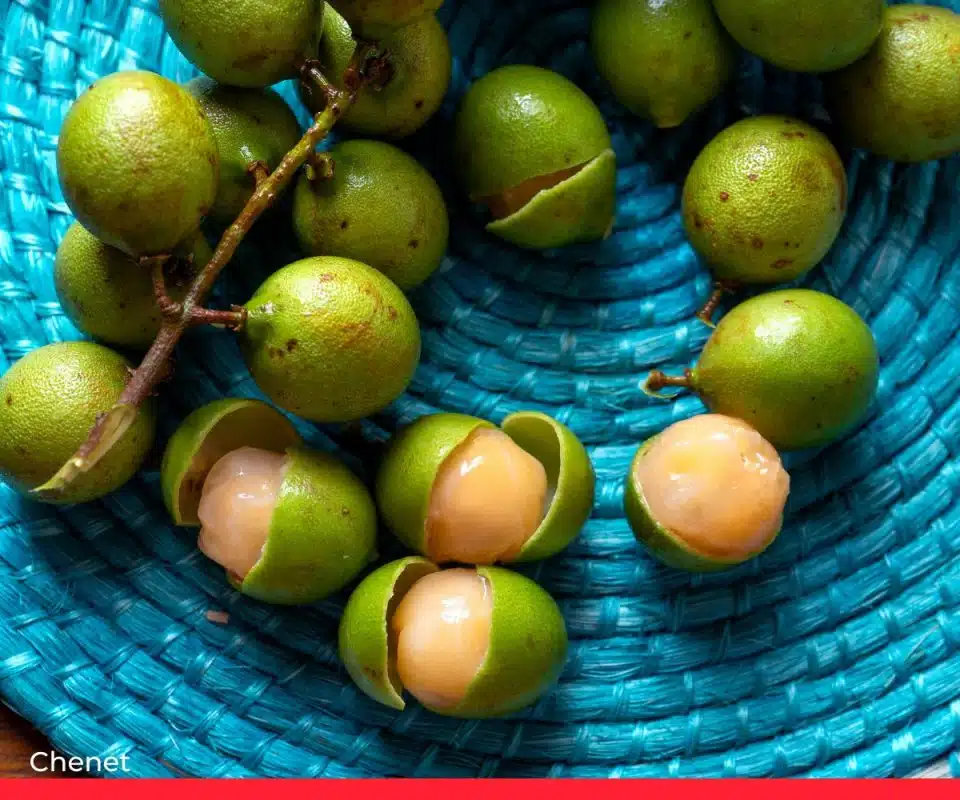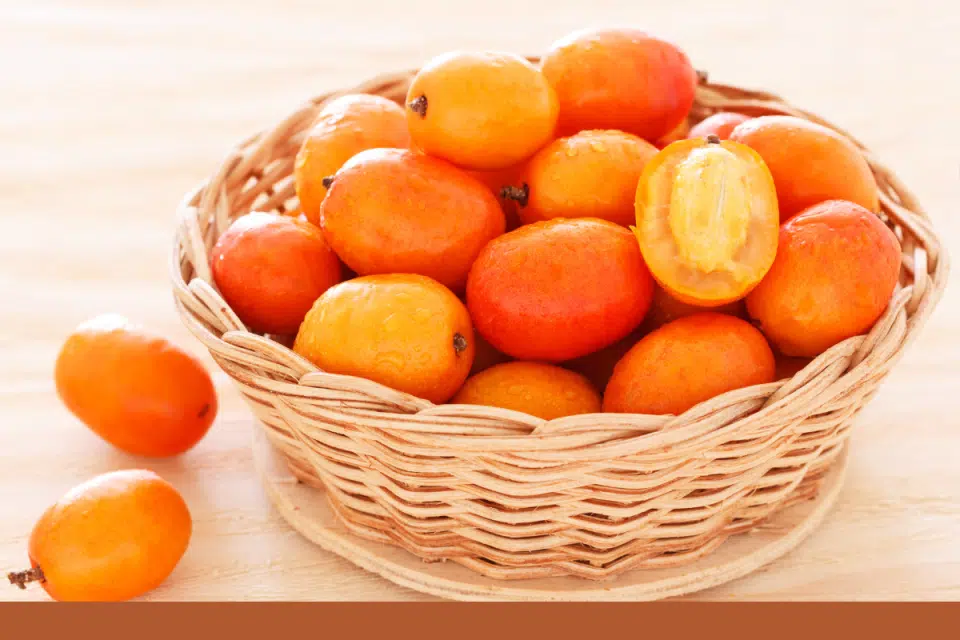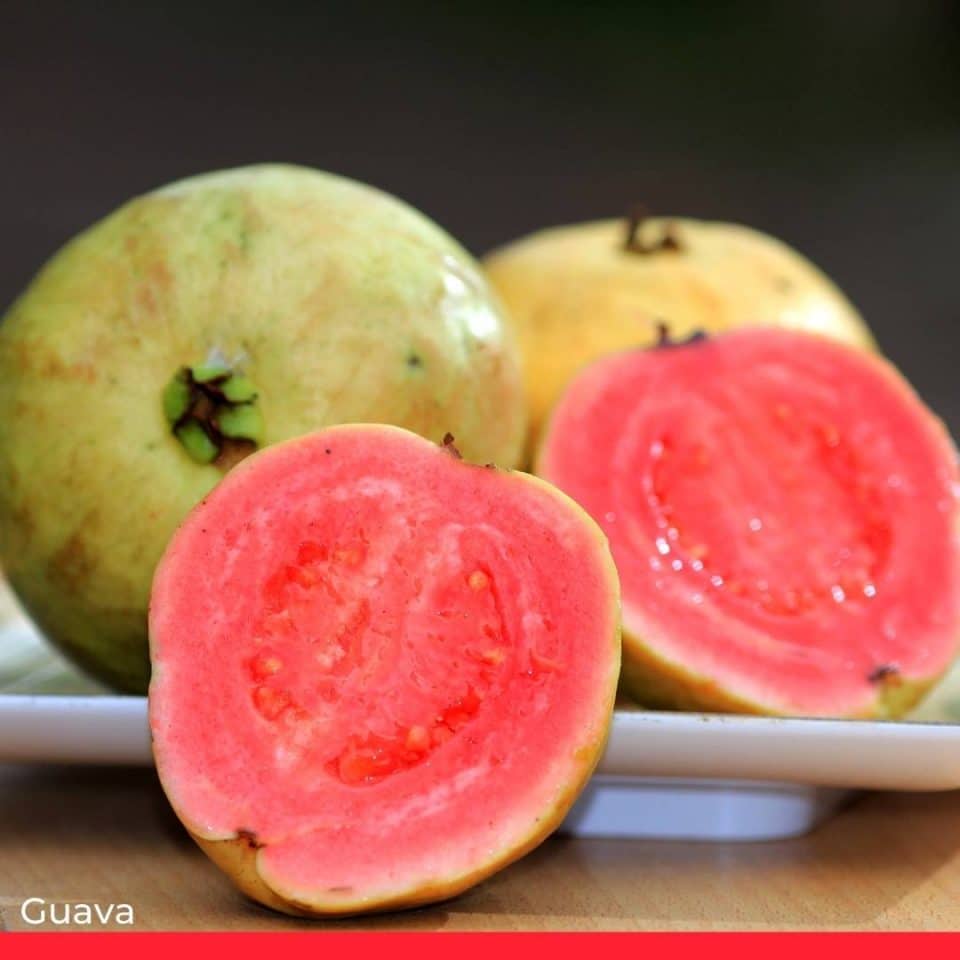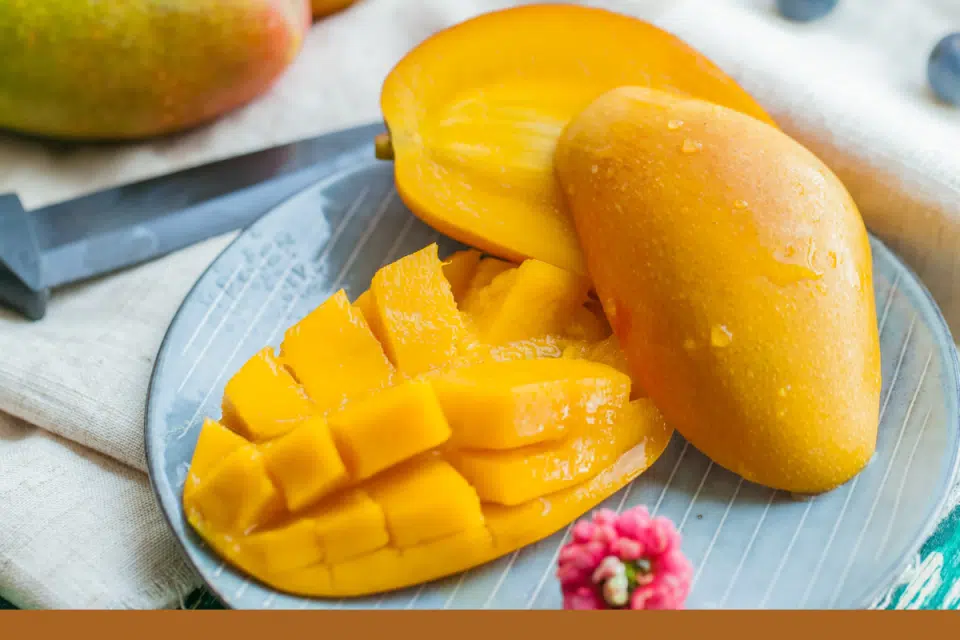The Republic of Trinidad and Tobago is a multi-ethnic twin island of incredible diversity and with a unique culture. Though this country is mostly known for its amazing Carnival, its cuisine is also a star attraction. And fruits play a key role with numerous delicious fruits in season throughout the year.
Many of the fruits from this country are due to the indigenous people from South America, other are the product of colonization, slavery, and immigration – the slaves from Africa, and the indentured laborers from India. This explains why this twin island has such a captivating cuisine, attracting people worldwide.
While there are countless fruits in this tropical paradise, this article goes through the top 20 fruits produced, cultivated, and consumed in Trinidad and Tobago. Many contain a number of vitamins, enhancing the daily diet and meaning they are prevalent in the Keto diet.
Note: Fruits largely considered vegetables do not feature in this article.
1. Bananas

Originating from Southeast Asia and Africa, bananas vary in size, shape, and taste. While most turn yellow when ripe, a minority remain green or reddish-purple, but they are all deliciously sweet. The bananas grown in Trinidad and Tobago include Chiquito, Gros Michel, Moco, Plantain, and Silk Fig.
Bananas are typically consumed raw but are frequently added to desserts, smoothies, and ice cream. They are recommended for potassium, fiber, folate, and vitamin C.
2. Breadfruit

You know when the breadfruit is ripe by the skin, which becomes light green with numerous brown spots, and the flesh becomes softer in texture and sweeter in flavor. Generally, breadfruit has a slight, starchy taste similar to a mild potato.
The islands have two distinct varieties, yellow and white: yellow is the most popular. Breadfruit can be eaten boiled, fried, or roasted. The most popular breadfruit dish is “oil down”! Native to New Guinea, breadfruit is known to be full of potassium, carbohydrate, and fiber.
3. Chenet

Chenet is a small green fruit with an easily broken shell revealing a seed covered in orange, sweet, tangy, and juicy pulp. It is a popular local fruit due to its fresh flavor.
It is mainly found on the island of Tobago, but it is native to Latin America and can grow up to 98 feet. Chenet is known to have lots of vitamins A, B, and C.
4. Coconut

Hidden in a hard, brown shell is the sweet meat of the coconut, which has a sweet flavor with a hint of a milky and wood tastes. Coconuts can be eaten in different forms and stages of growth, for example, coconut jelly, coconut water, coconut oil, and dry coconut.
Dry coconut is ideal for many recipes, such as sugar cake and milk for callaloo (a local dish). Coconut trees originated from Central Indo-Pacific and can reach up to 100 feet tall. The fruit is rich in antioxidants and has powerful antibacterial properties.
5. Cocorite

Cocorite is the national fruit of Trinidad and Tobago! It has a thick shell with pink flesh, a sweet, creamy flavor, and a long black seed.
It is eaten raw, though the pulp of the fruit is used for different products. It comes from the maripa palm, which can grow 115 feet high – quite tall! The cocorite tree is native to South America and contains many healthy oils, including vitamins C and E.
6. Dongs

Dongs are small and light green. They have a glossy skin and generally a sour flavor. This fruit is eaten green or ripe. On the islands, it is commonly used to make dong chow, a kind of fruit salad.
The dong originated from Central Asia, and the dong tree can grow as tall as to 15 feet. Dongs provide lots of protein and fiber and are low in calories.
7. Five Fingers

Five fingers are star-shaped fruits with a thin, tangy skin. It is generally consumed in juice and is rather delicious as a chow mixture of salt, hot pepper, and garlic. The tree is native to tropical Southeast Asia and only grows to a height of 30 feet. Five fingers are said to be rich in antioxidants and vitamin C.
8. Governor Plums

These plums start off green and then turn a bright yellow when ripe. They are round, red, moist, sweet, and have an acidic flavor. The tree is of Portuguese origin, arriving here in the 17th century, and can grow up to 72 feet tall.
Governor plums are rich in nutrients that help prevent arthritis, coughs, and colds. When used correctly, the leaf can heal cuts and wounds, as it is full of iron, vitamin C, sodium, and magnesium.
9. Grapefruit

Trinidad and Tobago have only two varieties of grapefruit: the yellow and the green. The Pink Marsh is the most popular and has an acidic yet sweet flavor. It is used in a variety of juices and cocktails.
The grapefruit tree is native to Asia and can reach up to 25 feet in height. Eating this fruit is known to boost the immune system.
10. Gru Gru Beff

Gru gru beff is the fruit of a palm tree. It is green-brownish and small, with sturdy thorns on the outer shell. It contains a white-yellowish pulp that has a sweet flavor.
Most people of the islands eat this fruit raw. It originated from the African and Central American continent and grows to 65 feet in height. The white pulp is very rich in oleic acid, which it is said to help with lowering cholesterol levels.
11. Guava

There are many types of guava tree: common guava, Detwiler guava, and cayenne guava. Common guava is dark green when ripe and has a sweet flavor. Cayenne guava is mint green in color with a white pulp that also has a sweet taste. However, Detwiler guava is bright yellow with bright pink flesh and white seeds and is slightly acidic.
All guavas are used to make jams, jellies, smoothies, and ice cream. The guava tree is native to India and grows up to 35 feet tall. Guavas are rich in potassium and iron.
12. Jackfruit

The outer skin of this fruit is spiky and green. When it turns yellow, you know it is fully ripe and has a fruity aroma and sweet taste. It is eaten raw and consumed in jams, juices, ice creams, and shakes. The fully grown seeds can be boiled and are known as a superfood.
This tree is native to South India and is the largest fruit in the world, weighing in at up to 121 pounds. Jackfruit is said to be rich in Vitamin C and protein.
13. Mangoes

There are many different varieties of mango grown in Trinidad and Tobago, such as Long mango, Graham, Starch Rose, and Julie. They are generally green or burgundy, but some types turn yellow when ripe. It has a sweet flavor, and the skin is smooth.
Mangoes can be consumed in numerous ways: jams, sauces, eaten raw, candies, shakes, cocktails, desserts, and the infamous chow. The tree is native to India and can grow up to 100 feet tall and live for over 100 years. Mangoes are known for lowering cholesterol and improving the immune system; the leaf is believed to contain medicinal properties.
14. Monkey Apple

This fruit is green with smooth skin and a creamy pulp. The flavor is sweet but has a bitter taste. Monkey apple is eaten raw and used in drinks and jam. It is generally a snack for children due to its unique texture, as they like the sticky, sweet flesh.
The fruit originated in South America and can reach as tall as 50 feet. It has medicinal properties and is rich in vitamins A and C, fiber, and antioxidants.
15. Oranges

These are round or oval, and the skin and flesh are orange. Oranges come in several varieties and types and contrast in taste, from sweet to acidic. They can be consumed raw, in chow, juice, cocktails, desserts, and jam.
The trees can grow up to 22 feet in height and originate from South China. These fruits are an excellent source of Vitamin C.
16. Pawpaw

Like the mango, there are various types of pawpaw and, it is also popular in the local chow. They can be yellow, orange, or pinkish, and contain many tiny black seeds. The skin is thick and smooth, and it turns yellow when ripe. Pawpaws are eaten in many dishes, jellies, shakes, and drinks.
The Pawpaw tree grows as tall as 26 feet and has a broad leaf. Pawpaw is known to be low in calories and high in fiber and is said to be good for weight loss and reducing stress and signs of aging.
17. Pomerac

Pomerac is pear-shaped and pinkish with a large brown seed. It has an acidic yet sweet taste. This fruit is generally eaten either raw or in candy form.
It also makes for a great homemade wine. Pomerac is native to Asia and the tree can reach up to 60 feet. Pomerac has a high water content, and it is said to help reduce inflammation, improve skin conditions, strengthen bones, and improve circulation.
18. Peewah

Peewah is yellow and orange. It cannot be eaten raw and has to cook for a minimum of five hours. Peewah is quite a popular fruit in Trinidad because of its sweet pulp. The tree can reach up to 66 feet in height and is a member of the palm family, native to Central and South America. The fruit possesses a lot of vitamins A, B, E, and K.
19. Pommecythere

This fruit has a green leathery skin and a rubbery seed. The pulp is crunchy with a bitter-sweet flavor and is used in pickles, candies, and chow. Pommecythere is native to the South Pacific Caribbean and Asia, where the tree grows up to 40 feet. The fruit is said to be full of fiber and iron.
20. Sapodilla

The sapodilla has a thin, light brown skin and oval-shaped black seeds. The pulp has a creamy flavor that makes a popular ice cream flavor on the islands. It is also consumed in smoothies and many other beverages.
The Sapodilla tree is native to Southern Mexico and Central America and can reach up to 26 feet. Sapodillas are believed to have anti-inflammatory properties and are used to treat coughs and colds. They also contain dietary fibers and vitamins A, B, and C.
Related: Most Famous Traditional Foods in Trinidad and Tobago
Related: Fruits of Barbados (What the Locals Eat)
Related: Top 25 Most Popular Caribbean Foods
The post The Most Popular Fruits from Trinidad & Tobago appeared first on Chef's Pencil.
from Chef's Pencil https://ift.tt/I8ZnLDY
via https://chefsspenncil.blogspot.com

No comments:
Post a Comment